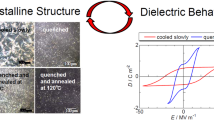Summary
Measurements of the dielectric constant and loss factor are reported for nylon 6, nylon 12 and 4,6-polyurethane over the frequency range 10−4 to 106 c/s and the temperature range 20 to 100 °C. The dc conductivity of these polymers were also measured. A new sort of loss maximum (αi loss) was measured for these polymers in the frequency range of 10−4 and 1 c/s, on the low frequency side of the α loss. The effects of crystallization and moisture on the αi loss were studied. The magnitude of dielectric dispersion increases with increasing crystallinity, and the frequency of loss maximum is nearly proportional to dc conductivity. The following three kinds of polarization process are examined for this phenomenon: (1) a molecular motion in the crystalline regions, (2) a proton jump passing through hydrogen bonds in the crystalline regions and (3) an interfacial polarization at the boundaries between crystalline and amorphous regions. It is concluded that the hypothesis (3) fits best to experimental results.
Zusammenfassung
Eine neue Art von Relaxationsverlusten wurde für Nylon 6, Nylon 12 und 4,6-Polyurethan gefunden. Dieses Phänomen ist durch folgende Eigenschaften charakterisiert:
-
1.
Die Größe der dielektrischen Verluste wächst mit steigender Kristallinität.
-
2.
Die Frequenz, bei welcher der Verlust sein Maximum zeigt, ist proportional zu der Gleichstromleitfähigkeit.
Drei Typen von Polarisationsprozessen für dieses Phänomen wurden diskutiert:
-
1.
Eine gewisse Art von molekularer Bewegung in kristallinen Bereichen.
-
2.
ein Proton-Sprung-Prozeß, der durch die Ketten der Wasserstoffbindungen in den kristallinen Bereichen läuft, und
-
3.
eine Grenzflächenpolarisation an den Grenzen zwischen kristallinen und amorphen Bereichen.
Es wird daraus geschlossen, daß die Ursache für den neuen Relaxationsprozeß eine Grenzflächenpolarisation ist, die in einem Mischsystem von niedrigstleitenden kristallinen Bereichen und hochleitenden amorphen Bereichen auftritt.
Similar content being viewed by others
References
Baker, W. O. and W. A. Yager, J. Amer. Chem. Soc. 62, 2171 (1942).
Boyd, R. H., J. Chem. Phys. 30, 1276 (1959).
McCall, D. W. and E. W. Anderson, J. Chem. Phys. 32, 237 (1960).
Stein, M. N., R. G. Lauttman, J. A. Sauer, and A. E. Woodward, J. Appl. Phys. 32, 2352 (1961).
Curtis, A. J., J. Res. NBS, A65, 185 (1961).
Müller, A. and R. Pflüger, Kunststoffe 50, 203 (1960).
Kilian, H. G. and E. Jenckel, Kolloid-Z. 163, 25 (1959).
Brenschede, W., Z. Elektrochem. 54, 191 (1950).
O'Brien, F. E. M., J. Sci. Instr. 25, 73 (1948).
Hamon, B. V., Proc. Inst. Electr. Eng. 99, pt IV, 151 (1952).
Nakajima, T., Bull. Electrotech. Lab. 24, 755 (1960).
Palevsky, H., R. Swank and R. Grenchik, Rev. Sci. Inst. 13, 298 (1947).
Nakajima, T. and S. Saito, J. Polymer Sci. 31, 423 (1958).
Fukada, E. and M. Date, J. Japan Soo. Test. Mater. 10, 344 (1961).
Jacobs, H. and E. Jenckel, Makromol. Chem. 43, 132 (1961).
Arisawa, K., K. Tsuge and Y. Wada, Japan. J. Appl. Phys. 4, 138 (1965).
Bueche, F., Physical Properties of Polymers (New York 1962) for example.
Kawaguchi, T., J. Appl. Polymer Sci. 2, 56 (1959) for example.
Sack, R. A., Aust. J. Sci. Res. A5, 135 (1952).
Wagner, K. W., Arch. f. Elektrochem. 2, 371 (1914).
Silars, R. W., J. Instn. Elect. Engrs. 80, 378 (1937).
Kharadly, M. M. Z. and W. Jackson, Proc. Instn. Elect. Engrs. 100 III, 199 (1953).
Amborski, L. E., J. Polymer Sci. 62, 331 (1962).
Author information
Authors and Affiliations
Rights and permissions
About this article
Cite this article
Hirota, S., Saito, S. & Nakajima, T. Dielectric loss in nylon 6, nylon 12 and 4,6-polyurethane in very low frequency range. Kolloid-Z.u.Z.Polymere 213, 109–115 (1966). https://doi.org/10.1007/BF01552519
Received:
Issue Date:
DOI: https://doi.org/10.1007/BF01552519




